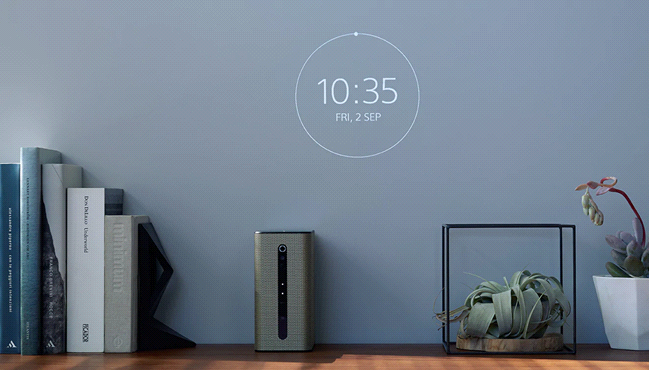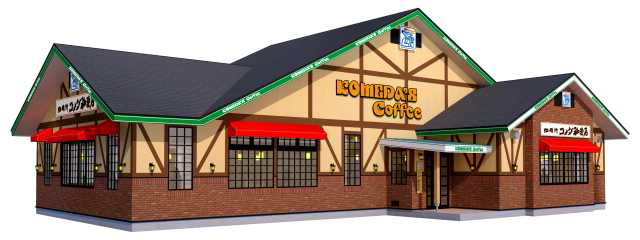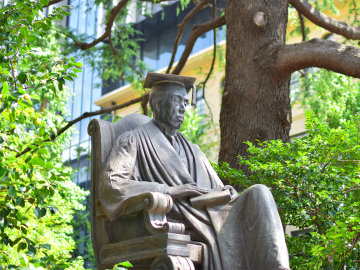Amendment to the Design Act 1959
Tatsuyuki SUEMUNE
Assistant Professor, Faculty of Law, Waseda University
(February 25, 2020)
On May 10, 2019, the Diet passed the “Bill of Partial Amendment of Patent Act, etc.” This bill, which includes provisions regarding the Design Act, represents the most considerable amendment made to the Design Act in several decades. The main part of the Act will be implemented on April 1, 2020.[i]
The summary of revisions was as follows:
(a) to expand the scope of protected images and newly apply the designs of the exteriors and interiors of buildings to the protection of the Design Act;
(b) to review the registration system of “Related Designs;”
(c) to prolong the terms of protection;
(d) to change the application procedure for design registration; and
(e) to revise the provisions of “Indirect infringement.”[ii]
I am going to explain the main changes focusing on above (a) and (b).
1. Background of the Amendment of the Design Act
The legislation regarding design protection in Japan includes the Design Act 1959, the Trademark Act 1959, the Copyright Act 1970, and the Unfair Competition Prevention Act (UCPA) 1993.[iii]
The Design Act is aimed at protecting industrial designs and has a structure similar to that of the Patent Act[iv]. In order to obtain a design registration, it is necessary to file an application with the Japan Patent Office for a design that satisfies conditions such as novelty and creative difficulty[v] (Articles 3 and 6).
Under the Copyright Act, a design may be copyrighted if it constitutes a “work” with creativity (Art. 2(1)(ⅰ)). However, controversy exists regarding what design constitutes a “work” in the meaning of the Copyright Act, and there is no consensus in the lower courts’ decisions.[vi]
The measures for design protection under the UCPA can be roughly classified into two types: Art. 2(1)(ⅰ) and Art. 2(1)(ⅲ). The former provision provides legal protection for “indication of goods, etc.” In other words, it can be said to substantially protect unregistered trademarks. The latter provision, which was introduced in 1993, prohibits the slavish imitation of configurations of goods, in order to protect the first-mover advantage.[vii] The protection is short-term protection that ends “three years […] from the day on which [goods] were first sold in Japan.”[viii]
In 1996, the three-dimensional trademark system was introduced into the Trademark Act. There are trademark registrations for product shapes as well as containers or packaging, for example, Coca-Cola bottles.[ix]
Recently, the momentum for reviewing the Design Act, which is the primary measure to protect industrial designs, has increased. This momentum relates to the increasing difficulties of differentiating between products’ technologies and functions, and to the growing importance of design in the market. On May 23, 2018, the Study Group on the Relation between Industrial Competitiveness and Designs, which was established by the Japan Patent Office (JPO) of Ministry of Economy, Trade and Industry (METI), drew up a report titled “Declaration of Design Management.” This report states that the Design Act should be drastically revised in order to simplify procedures as well as to expand the scope of subject matter, such as the design of new products or services using new technologies and designs of a group of products, based on consistent concepts.[x] In response to this, from August 2018, the Design System Subcommittee, Intellectual Property Committee, Industrial Structure Council, METI considered the new design protection system, which should correspond to the diffusion of new technologies and contribute to innovation and brand strategies. In February 2019, the Subcommittee compiled a report titled “Review of the Design System Contributing to Strengthening Industrial Competitiveness.”[xi]
The amendments made in 2019 were based on the above report. It has been pointed out that the revision made in 2019 represents the most considerable revision of the Design Act since 1998.[xii]
2. Contents of the revision
(a) Expansion of subject matter under the Design Act 1959: Images, and interior and exterior of architecture
(1) Expanding protection on Images
It has been pointed out that image designs, which are not physically fixed, were considered to be unsuitable for protection under the Design Act, as the Act was originally aimed at protecting tangible objects.[xiii] The first substantial protection provision for image design in the Design Act was the introduction of the partial design system in 1998.[xiv] The introduction of the partial design system meant that the display screen of an article could be registered as a partial design. Since this point, the development of digital technology has led to the protection of image designs being reviewed. Specifically, there have been two revisions to the Act and three revisions to the Design Examination Guidelines.[xv],[xvi]
However, the images protected under the previous Act were limited to two kinds of images: (1) images displayed on the article, which make necessary indications for performing the function of the article and, or (2) images which are “provided for use in the operation of the article […] and [are] displayed on the article itself or another article that is used with the relevant article in an integrated manner[xvii]” under Art. 2(2) of the Design Act. Also, the Design Examination Guidelines required that such images need to be recorded on an article to be protected.[xviii]
Other Intellectual Property (IP) laws may provide protection for image designs. Images can be classified as “works,” which are protected under the Copyright Act 1970, but there are difficulties in establishing infringement regarding idea/expression dichotomy.[xix] Art. 2(1)(ⅰ) of the UCPA may also protect image designs. However, it has been pointed out that it is difficult for images on games to fulfill one of the requirements of Art. 2(1)(ⅰ), namely “indications of goods, etc.”[xx]
The subcommittee report noted that the constraints on image design protection highlighted above no longer match reality, due to the spread of new technologies such as the Internet of Things (IoT).[xxi] The report then recommended that it is appropriate to protect operation images and display images, whether they are recorded on an article or not, and whether they are displayed on an article or not.[xxii] However, the report adds that images such as those used as wallpapers, and in movies and games, should not be protected under the Design Act, because they are not related to the functions of the devices to which the images relate, and because they do not directly enhance the value of the devices.[xxiii] The underlying idea of this policy seems to be that those images should not be protected by the Design Act, but by Copyright Law.[xxiv]
The amended Act adds to the definition of “Design” the following: “images (limited to those provided for the operation of the devices to which the images relate or those displayed as a result of the devices performing their function)” (Article 2(1) of the amended Act). Under the amended Act, both images that are not recorded on an article[xxv] and those that are not displayed on an article[xxvi] may be registered.
(2) Interiors and exterior of architecture newly protected under the Design Act
The definition of “design” is the shape of an article (Article 2(1)). The commonly accepted interpretation of the term “article” is that it refers to a movable tangible object. Therefore, architecture designs were excluded from protection under the Act.
Interior designs, which consist of the combination and arrangement of furniture and fixtures, the decoration of a part of a building, etc., have been excluded from the protection, as they are not considered to fall under “Design for a set of articles” (Art. 8), which is an exemption from the principle of “One application per design” (Art. 7).[xxvii]
Architecture designs, on the other hand, can be protected under other IP laws.
The Copyright Act provides for “works of architecture” as one of the examples of works (Art. 10(1)(ⅲ) of the Copyright Act). The commonly accepted view and case law are to deny copyrightability to ordinary houses. This position is based on the grounds that what can be regarded as works of architecture under the Act shall be “work of formative art.”[xxviii] For example, in the “Gurunie-dain” case,[xxix] the court ruled that the plaintiff’s house did not constitute a “work of architecture” because it was not sufficiently creative to be regarded as a work of formative art. Therefore, the scope of protection on architectural works is considered to be relatively narrow.[xxx]
Art. 2(1)(ⅰ) of the UCPA is also noteworthy. There have been academic discussions as to whether the interiors and exteriors of shops or restaurants can be protected under Art.2 (1)(ⅰ). The relating judgments on this topic are the “Gohan-ya Maido Okini” case[xxxi] and the “Komeda Coffee” case.[xxxii] [xxxiii] In the “Komeda Coffee” case, the Plaintiff argued that their shop appearance, including its exteriors and interiors, which were commonly or typically used in shops in the suburbs belonging to a major coffee chain “Komeda Coffee,” constituted “indications of goods, etc.” The court granted the plaintiff’s claim and issued the order. The “Komeda Coffee” judgment is considered to be the first ruling to protect the appearance of stores under Art. 2(1)(ⅰ). Indeed, Art. 2(1)(ⅰ) is a useful means for protecting architectural designs. However, it has been pointed out that Art. 2(1)(ⅰ) does not protect until the design in question has become “well-known as one of the requirements is being “well-known.”[xxxiv]
Architectural designs may also be protected as three-dimensional trademarks under the Trademark Act. Such registered three-dimensional trademarks are usually combined with characters and figures.[xxxv] However, there have been some registrations where buildings alone have been registered as trademarks.[xxxvi] From the perspective of straightening the protection of the interior and exterior of shops, the Ordinance for Enforcement of the Trademark Act has been revised and the Examination Guidelines for Trademark is being revised.
Regarding the amendment to the Design Act in 2019, the subcommittee report highlighted that there were limitations of protection under other laws, including the Copyright Act and the UCPA, while the importance of design has increased in the field of buildings, in the light of creating brand value[xxxvii]. Furthermore, according to the report, the appearances and interiors of architecture have been protected both in the US and Europe.[xxxviii] In conclusion, the report recommended adding “Architecture” to the scope of protection under the Design Act, in addition to “article.”[xxxix] Furthermore, the report suggested that design registrations for interiors should only be allowed as an exception to the principle of “One application per design” (Art. 7) if the interior creates a “uniform aesthetic impression as a whole.”[xl]
The amended Act adds “Architecture” to the definition of design (Art. 2(1) of the amended Act). The law also stipulates that “Where an article, architecture or image, or any combination thereof are used for equipment and decoration inside a store, office or other facilities (hereinafter referred to as ‘interior’) if the interior creates a uniform aesthetic impression as a whole, an application for design registration may be filed as one design.”[xli] (Art. 8bis of the amended Act)
The notion of “Architecture” is not defined in the amended Act, so it is open to interpretation.[xlii] Ultimately, we should wait for the court’s decision, but the examination guidelines as the JPO’s opinion may be useful to some extent. According to the proposal for revision to the Examination Guidelines for Design in accordance with the revised Act in 2019, in order to constitute a design of “Architecture” registrable under the Act, it is necessary to satisfy two requirements: “being fixtures of the land” and “being artificial structures including civil structures.”[xliii]
Regarding interiors, the interpretation of the requirement for “a uniform aesthetic impression as a whole” in Article 8bis of the amended Act will be disputable. On the one hand, there is a view that this requirement should not be given a substantive meaning, and should be interpreted in a very broad sense.[xliv] On the other hand, it should be considered that the term “unified” is important, and that it should be interpreted more strictly in the manner of protecting only those cases that have undergone a creative process.[xlv]
(b) Revision of the Registration System of “Related Designs”
The Registration System of “Related Designs” is a system under which a group of designs that are similar to each other may be registered under certain conditions. Applications for similar designs should usually be refused under the provisions of the earlier application, that is, Art. 9. However, if the same applicant seeks to register similar designs (“Principal Design” refers to a selected design from them; “Related Design” refers to a design similar to “Principal Design”) and if the filing date regarding the Related Design application is on or after the filing date of the principal design application and before the date when the design gazette regarding Principal Design is issued, then the applicant may obtain design registration of Related Design (Article 10 (1)).
The amended Act provides that the registerable term of Related Design shall be extended to ten years from the application date of Principal Design (Article 10 (1) of the amended Act). According to the subcommittee report, the aim of this amendment is to protect designs that are continuously changing based on consistent concepts, over a long period of time.[xlvi] With the extension of the registerable term, the Act also provides for exceptions to the lack of novelty and creative difficulty regarding the relationship between principle design and related design (Article 10 (2) and (8) of the amended Act). Of course, designs anticipated by another person should still be considered under novelty or creative difficulty requirements.
Article 10 (3) previously provided that a design similar only to a Related Design shall not be registered, to avoid an infinite chain of the registration of Related Designs.[xlvii] However, the Subcommittee report in 2018 suggested that the registration of a design similar only to a Related Design should be granted, in light of the spreading of methods that are gradually improving previous designs.[xlviii] Under this view, therefore, an infinite chain of the registration of Related Designs may be allowed.[xlix]
Due to limitations of space, this article dealt only with amendments (a) and (b). Other changes are also important though. Since this amendment includes significant issues, more active discussions will take place.
[Acknowledgement]
Advice and comments by Mr. Takuji ADACHI (Patent Attorney) and Mr. Asuka GOMI (Patent Attorney) have been a great help in writing this article. Also, I would like to thank Prof. Akiko OGAWA (Yamaguchi Univ.) and Editage (www.editage.com) for English language editing.
―――――――――――――――――――――
[i] The Cabinet adopted the Cabinet Order for Stipulating the Enforcement Date of Partial Revision of the Patent Act, etc. on Nov. 1, 2019. (See https://www.meti.go.jp/english/press/2019/1101_002.html).
[ii] See Press release of JPO regarding the Act of Partial Amendment of Patent Act, etc. (May, 2019) (https://www.jpo.go.jp/system/laws/rule/hokaisei/tokkyo/document/tokkyohoutou_kaiei_r010517/01.pdf; in Japanese).
[iii] See e.g. Takamitsu Shigetomi ‘Japan’ in Clive Thorne (Consulting ed) International Design Protection: A Global Handbook (Global Law and Business 2nd edn, 2017) 173ff (providing a basic overview of design protection in Japan, written in English.)
[iv] It seems to be similar to the U.S. Design Patent System.
[v] Notwithstanding Article 3, the designs referred to in Article 5 shall not be registered.
[vi] Intellectual Property High Court recently issued two notable rulings. One is the “Fashion Show” case judgment, which adopted the criteria considered to be similar to the “separability” test in the US (Judgment of IP High Ct. on Aug. 28, 2014, Hanrei-jiho vol. 2238 p.91; English ver. available: http://www.ip.courts.go.jp/app/files/hanrei_en/296/001296.pdf). The other is the “TRIPP TRAPP” case judgment, which adopted the criteria considered to be similar to “l’unite de l’art” in France and the EU (Judgment of IP High Ct. on Apr. 14, 2015, Hanrei-jiho vol. 2267 p.91; English ver. Available: http://www.ip.courts.go.jp/app/files/hanrei_en/861/001861.pdf). Articles dealing with this topic and these judgments have been written in English: e.g. Tatsuhiro Ueno “Cumulative Protection for Applied Arts and the Role of Copyright” in Stefania Ercolani (ed) Applied Arts under IP Law (Aracne editrice 2018) 185ff and Masahiro Motoyama “The Copyright/Design Interface in Japan” in Estelle Derclaye (ed) The Copyright/Design Interface: Past, Present and Future (CUP 2018) [11.2.1].
[vii] Intellectual Property Policy Office, METI (ed) Chikujyo Kaisetsu Fusei-kyoso-boshi-ho (Shoji-homu 2nd edn 2019) 81. Article on the history and background of the introduction of Article 2 (1) (iii) and related caselaw is described in English: Yoshiyuki Tamura ‘Protection of the first mover advantage: Regulation against imitation of the product configuration in Japan’ in Nari Lee et al. (eds) Intellectual Property, Unfair Competition and Publicity (Edward Elgar 2014) 222, 229. See also Christopher Heath The System of Unfair Competition Prevention in Japan (Kluwer 2001) 124-126 and Moritz Bälz et al.(eds) Business Law in Japan – Case and Comments (Kluwer 2012) 595ff (Christopher Heath).
[viii] The text of the UCPA does not address when the protection starts. IP High Court in “Tube-like Humidifier” case adjudged this issue: Judgment of IP High Ct. on Nov. 30, 2016, Hanrei-jiho vol. 2338 p.96; English ver. Available: http://www.ip.courts.go.jp/app/files/hanrei_en/125/002125.pdf
[ix] Judgment of IP High Ct. on May 29, 2008, Hanrei-jiho vol. 2006 p.36; English ver. Available: http://www.ip.courts.go.jp/app/files/hanrei_en/062/000062.pdf. An article dealing with this judgment is written in English: Yoshiyuki Tamura ‘Three-dimensional shape of Coca-Cola bottles registrable: Acquired distinctiveness evidenced by a questionnaire in Japan’ in Kung-Chung Liu (ed) Annotated Leading Trademark Cases in Major Asian Jurisdictions (Routledge 2019). See also Moritz Bälz et al.(eds) (n vii) 531ff (Christopher Heath)
[x] Study Group on the Relation between Industrial Competitiveness and Designs, Declaration of Design. Management (May 23, 2018, https://www.meti.go.jp/press/2018/05/20180523002/20180523002-1.pdf; in Japanese) p. 11; See also Study Group on the Relation between Industrial Competitiveness and Designs, [ANNEX] Shaping Japan’s Design Registration System (May 23, 2018, https://www.meti.go.jp/press/2018/05/20180523002/20180523002-2.pdf; in Japanese).
[xi] Design System Subcommittee, Intellectual Property Committee, Industrial Structure Council, METI, Review of the Design System Contributing to Strengthening Industrial Competitiveness (Feb. 2019)(https://www.jpo.go.jp/resources/shingikai/sangyo-kouzou/shousai/isho_shoi/document/isyou_seido_190215_minaoshi/01.pdf; in Japanese).
[xii] E.g. Tsukasa Aso, Isyoho Kaisei, Hogaku-kyoshitsu vol.469 (2019) p.65, Takeo Matsumoto Reiwa-gan-nen Tokkyoho-tou-kaisei no Gaiyo, Copyright vol. 702 (2019) p.38.
[xiii] Mitsuda Shigeaki & Kazuko Matsuo (eds) Chukai Isyoho (Seirin-shoin 2010) 125 (Ryoji Saito).
[xiv] Before the introduction of the partial design system, “Buppin no hyoujibu ni hyoujisareru zukei-tou ni kansuru isyo no shinsa-kijyun” (Design Examination Guidelines) had been established by JPO in 1986.
[xv] “[T]wo revisions to the Act and three revisions to the Design Examination Guidelines” means the revisions made to the Act in 1998 and 2006, and the revisions made to the Guideline in 2007, 2011, and 2016.
[xvi] Miwa Hayashi Isyoho Hogotaisyo wo kakuju Business Law Journal vol. 138 (2019) p.20.
[xvii] This translation is cited from Japanese Law Translation. (http://www.japaneselawtranslation.go.jp/ last visited Feb. 25, 2020)
[xviii] The situation before this amendment is described in English: Shigeki Chaen (ed) Intellectual Property Law in Japan (Hatsumei-suishin Kyokai 2017) 167-169.
[xix] Judgment of IP High Ct. on Aug. 8, 2012, Hanrei-jiho vol. 2165 p.42; English ver. Available: http://www.ip.courts.go.jp/app/files/hanrei_en/707/000707.pdf
[xx] See e.g. Judgment of Tokyo District Ct. on Nov. 29, 2013, (Hei 23 (wa) 29184) (Summary available in English: http://www.ip.courts.go.jp/app/files/hanrei_en/088/001088.pdf)
[xxi] Design System Subcommittee, (n xi) 2.
[xxii] Design System Subcommittee, (n xi) 3.
[xxiii] Design System Subcommittee, (n xi) 3.
[xxiv] See Handout of Yoshiyuki Tamura (Public Lecture) 45th RCLIP Seminar (Waseda Univ. Aug. 24, 2019), Hiroya Aoki ‘Isyoho-kaisei’ in Ryu Takabayashi et al., (edn) Nenpo Chitekizaisanho 2019-2020 (Nihon-hyoronsya 2019) 4.
[xxv] NAVITIME Japan(Images are cited from JPO Isyo-seido no Minaoshi no Kento-kadai (Aug. 6, 2018) 12(https://www.jpo.go.jp/news/public/iken/document/180807_isho_seido/01.pdf; in Japanese (last visited Feb. 25, 2020)).
[xxvi] SONY Any Surface (https://www.sony.co.jp/SonyInfo/design/stories/anysurface/ (last visited Feb. 25, 2020)) (This product is also mentioned in JPO Isyo-seido no Minaoshi no Kento-kadai (Aug. 6, 2018) 13 (https://www.jpo.go.jp/news/public/iken/document/180807_isho_seido/01.pdf; in Japanese (last visited Feb. 25, 2020)) Image is cited from the SONY HP.

[xxvii] Design System Subcommittee, (n xi) 5.
[xxviii] E.g. Moriyuki Kato Chosakukenho-chikujyo-kogi (CRIC New edn: 6 Supp. 2013) 123.
[xxix] Judgment of Osaka District Ct. on Oct. 30, 2003, Hanreijiho vol.1861, p.110. The appellate court judgment is Judgment of Osaka High Ct. on Sep. 29, 2004, LEX/DB 28092570 (English ver. available: http://www.ip.courts.go.jp/app/files/hanrei_en/915/001915.pdf).
[xxx] “Log House Style Wooden House” judgment adopted similar criteria for the “separability” test: Judgment of Tokyo District Ct. on Oct. 17, 2014, LEX/DB 25447065.
[xxxi] Judgment of Osaka District Ct. on July 3, 2007, Hanreijiho vol. 2003, p.130 (Summary available in English: http://www.ip.courts.go.jp/app/files/hanrei_en/266/001266.pdf); The appellate court judgment is Judgment of Osaka High Ct. on Dec. 3, 2007 (Hei 19 (ne) 2261).
[xxxii] Judgment (Order) of Tokyo District Ct. on Dec. 19, 2016, Westlaw Japan document number 2016WLJPCA2196001.
[xxxiii] Additionally, the “Nishimatsuya” judgment adjudged on whether goods display designs constitute “indications of goods etc.” (Judgment of Osaka District Ct. on Dec. 16, 2010 Hanreijiho vol. 2118, p.120; Summary available in English: http://www.ip.courts.go.jp/app/files/hanrei_en/577/000577.pdf).
[xxxiv] Design System Subcommittee, (n xi) 5.
[xxxv] SunBusiness Tenpo no gaikan tou (Trade Dress) ni kansuru seido/unyo ni tuite no chosa-kenkyu houkokusyo (Mar. 2019) 12.
Reg.No.5851632.
[xxxvi] For example, registrations where buildings alone are registered are as follows.
Reg.No.5751309.
[xxxvii] Design System Subcommittee, (n xi) 5.
[xxxviii] Design System Subcommittee, (n xi) 5.
[xxxix] Design System Subcommittee, (n xi) 5.
[xl] Design System Subcommittee, (n xi) 5.
[xli] Translated by the author, not a formal translation nor cited from “Japanese Law Translation.”
[xlii] There is an opinion that the notion of “Architecture” can be interpreted to include ordinary houses, bridges, and so on, as well as shops and offices. (Aoki (n xxiv) 6).
[xliii] “Proposal for Revision to the Examination Guidelines for Design” at [6.1.1.1] (https://www.jpo.go.jp/resources/shingikai/sangyo-kouzou/shousai/isho_wg/document/19-shiryou/02.pdf; last visited Feb. 25, 2020)
[xliv] Yuka Matsuno et al., Kukan-design no hotekihogo in Takabayashi et al., (eds) (n xxiv) 44-45 (Shigeki Chaen)
[xlv] Yoshiyuki Tamura Focus Kaisei-isyoho no business impact Business Law Journal vol. 139 (2019) p.19
[xlvi] Design System Subcommittee, (n xi) 7.
[xlvii] The system was introduced in 1998 after the issue of a design subcommittee report: Design Subcommittee, Industrial Property Council, MITI Design-sozo-jidai he mukete (Nov. 1997). According to the report in 1997, if such an infinite chain was allowed, Related Designs might include designs that were dissimilar to each other. Then, even dissimilar designs would have to be subject to limitations under the Registration System of Related Designs. However, this reasoning seems to be based on policy considerations rather than theoretical considerations.
[xlviii] Design System Subcommittee, (n xi) 8.
[xlix] Design System Subcommittee, (n xi) 9.







